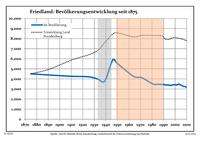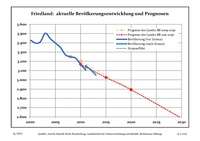Friedland, Brandenburg
| Friedland | ||
|---|---|---|
| ||
 Friedland | ||
Location of Friedland within Oder-Spree district | ||
| Coordinates: 52°06′N 14°16′E / 52.100°N 14.267°ECoordinates: 52°06′N 14°16′E / 52.100°N 14.267°E | ||
| Country | Germany | |
| State | Brandenburg | |
| District | Oder-Spree | |
| Government | ||
| • Mayor | Thomas Hähle (Ind.) | |
| Area | ||
| • Total | 173.21 km2 (66.88 sq mi) | |
| Population (2015-12-31)[1] | ||
| • Total | 3,017 | |
| • Density | 17/km2 (45/sq mi) | |
| Time zone | CET/CEST (UTC+1/+2) | |
| Postal codes | 15848, 15868 | |
| Dialling codes | 033676 | |
| Vehicle registration | LOS | |
| Website | www.friedland-nl.de | |
Friedland (Lower Sorbian Bryland) is a town in the Oder-Spree district, in Brandenburg, Germany. It is situated in the historic Lower Lusatia region, about 8 km (5.0 mi) south of Beeskow, and 39 km (24 mi) north of Cottbus.
History
![]() March of Lusatia 1235-1367
March of Lusatia 1235-1367
![]() Kingdom of Bohemia 1367-1469
Kingdom of Bohemia 1367-1469
![]() Kingdom of Hungary 1469-1490
Kingdom of Hungary 1469-1490
![]() Kingdom of Bohemia 1490-1635
Kingdom of Bohemia 1490-1635
![]() Electorate of Saxony 1635-1697
Electorate of Saxony 1635-1697
![]() Poland-Saxony 1697-1706
Poland-Saxony 1697-1706
![]() Electorate of Saxony 1706-1709
Electorate of Saxony 1706-1709
![]() Poland-Saxony 1709-1763
Poland-Saxony 1709-1763
![]() Electorate of Saxony 1763-1806
Electorate of Saxony 1763-1806
![]() Kingdom of Saxony 1806-1815
Kingdom of Saxony 1806-1815
![]() Kingdom of Prussia 1815-1871
Kingdom of Prussia 1815-1871
![]() German Empire 1871-1918
German Empire 1871-1918
![]() Weimar Republic 1918-1933
Weimar Republic 1918-1933
![]() Nazi Germany 1933-1945
Nazi Germany 1933-1945
![]() Allied-occupied Germany 1945-1949
Allied-occupied Germany 1945-1949
![]() East Germany 1949-1990
East Germany 1949-1990
![]() Germany 1990-present
Germany 1990-present
The town was first mentioned as Fredberg in a 1235 deed issued by the Lusatian margrave Henry III of Meissen. A 1301 contract signed by Margrave Frederick I named a town and castle of Vredeburch, then a possession of the Lords of Strehla, who served as ministeriales of the ruling House of Wettin. The present name first appeared in a 1350 bull issued by Pope Clement VI. With Lower Lusatia, Friedland passed under the suzerainty of the Bohemian Crown in 1367.
In 1518, the lordship was pawned to the Order of Saint John and turned Protestant in 1540. Under the rule of Lord Master Count Adam of Schwarzenberg, the fortifications were enlarged, nevertheless Friedland suffered severely under the impact of the Thirty Years' War. Upon the 1635 Peace of Prague, it passed with the Lusatias to the Electorate of Saxony. Under Master Prince John Maurice of Nassau-Siegen the lordship quickly recovered. Town privileges were confirmed in 1662, a Jewish community is documented since 1673.
After almost three-centuries rule of the Order of Saint John, Friedland was finally secularised to Saxony in 1811. Only four years later, the town passed to the Prussian province of Brandenburg upon the Final Act of the 1815 Vienna Congress.
Demography

Friedland is the least densely populated town ("Stadt") in Germany, just narrowly beating Baruth/Mark (also in Brandenburg) for that distinction.
 Development of Population since 1875 within the Current Boundaries (Blue Line: Population; Dotted Line: Comparison to Population Development of Brandenburg state; Grey Background: Time of Nazi rule; Red Background: Time of Communist rule)
Development of Population since 1875 within the Current Boundaries (Blue Line: Population; Dotted Line: Comparison to Population Development of Brandenburg state; Grey Background: Time of Nazi rule; Red Background: Time of Communist rule) Recent population development (blue lines) and projections (dotted lines)
Recent population development (blue lines) and projections (dotted lines)
|
|
|
|
Detailed data sources are to be found in the Wikimedia Commons.[3]
References
| Wikimedia Commons has media related to Friedland (Niederlausitz). |
- ↑ "Bevölkerung im Land Brandenburg nach amtsfreien Gemeinden, Ämtern und Gemeinden 31. Dezember 2015 (Fortgeschriebene amtliche Einwohnerzahlen auf Grundlage des Zensus 2011)". Amt für Statistik Berlin-Brandenburg (in German). 2016.
- ↑ Boundaries as of 2013
- ↑ Population Projection Brandenburg at Wikimedia Commons
.png)